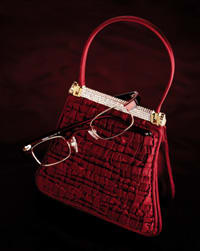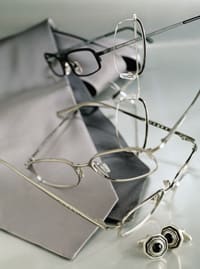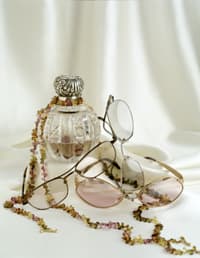|
|
|
|
Although times are tight, there's always a demand from consumers for luxurious and elegant touches such as this Delphina satin evening bag by Judith Leiber and Missoni 21901 eyewear for Neostyle. |
|
The Luxury Challenge
How to sell high-end
eyewear in
a down
economy.
By Marcy Bruch
Photography by Peter Baker
Product Stylist: Kate Williams
Jewelry and accessories: Courtesy of Mitchell's of Westport & Richard's of Greenwich, CT
What a difference a year makes. The first half of 2001 saw a cautious middle America collectively tightening its belt while high-end business bustled as usual. By the second half of last year, luxury conglomerates felt the rippling effect of the looming recession, too. Still, in optical retailing, those who have crossed over into the high-end arena don't regret the move. "I decided to offer more upscale product back in 1995 when I saw how profit margins were shrinking due to third-party billing," says Chris Cannella, owner of Specs of Westport in Connecticut. "It turned out to be one of the wisest business decisions I've ever made."
Even so, today's economic climate makes selling high-end eyewear more challenging. "The higher eyewear is priced, the more it is perceived as a luxurious fashion accessory and the less it is perceived as a medical necessity," points out Cynthia Leight, owner of Cynthia Leight Opticians in Los Angeles. "So service, quality, and exclusivity become all the more important to keep business afloat."
In fact, since September 11th, the consensus among high-end optical retailers across the country is that keeping business afloat hasn't been easy. "Before the terrorist attacks, I could count on a certain amount of business every day," says Leight. "But just this week alone, my only sale for one day came from a wealthy TV producer who spent $7,000. The next day's sales totaled zero. This roller coaster in business is happening on a monthly basis too. For example, October was my worst month since I opened the store two-and-a-half years ago. Yet last November was my best November ever. Go figure."
|
|
|
|
Gentlemen's choice: Top to bottom: Dolce & Gabbana DG368 for Marcolin; Hugo Boss HG155 30E for CXD (Charmant Exclusive Division); Donna Karan style 8611 for Marchon; Richard Morgenthal style Neptune. Ties by Ermenegildo Zegna. Silver and onyx cuff links by Catherine Zadeh. |
RECONNECT WITH REPEAT CUSTOMERS
So how does one strategize to offset such volatility? "Since our tourist business is down, we're making more of an effort to reconnect with local customers," says Heather Gherardi, manager of l.a. Eyeworks in Southcoast Plaza, Costa Mesa, Calif. "We send out postcards inviting them to come in to get their glasses cleaned and adjusted. It's an opportunity for the optician to establish a relationship with them and find out what kind of eyewear they like. That way, if something new comes in, the optician can follow up with a phone call and tell them about new products without it seeming like a cold call."
Cannella observes a similar pattern on the East Coast. "Most of the traffic comes from the local community. Lately, people aren't going out of their way to shop. That's why now more than ever, service counts. A high level of service creates loyalty which brings repeat business, and during times like these, the amount of loyal customers you have can make or break your business."
KEEP INVESTING IN YOUR BUSINESS
Cannella notes that it's important to keep investing in new product and upgrading your retail environment. "I had just ordered $5,000 worth of new lighting the week of the terrorist attacks," says Cannella. "My first reaction was to cancel the order, but then I realized that I would just be contributing to the belt-tightening ripple effect. After all, if I'm not spending, why should I expect my customers to spend?"
In fact, George Lee has so much faith, he opened a new dispensary called the Nakedeye in lower Manhattan just two months after September 11th. Located in the East Village on Orchard Street, Lee says that the area is an up-and-coming neighborhood blossoming with trendy boutiques where lots of musicians, designers, and artists reside. "I've lived in this area for more than 20 years, so I know my customers are looking for eyewear that is unique and reflects their artistic personalities. I had planned to open this store for over a year, and continued as scheduled. Because no matter what the economy, when there's a void in the market, there's still an opportunity," he maintains. "In order to succeed in high-end eyewear, you have to offer product that's not available on every street corner."
|
|
|
|
The sweet smell of success: Left to right: Toki TK8425 for Toki Eyewear; Chopard C062 for Eastern States Eyewear; Stella GD1F7 for Beausoleil. Three-strand, pearl-wrapped necklace by Talisman. |
|
MAINTAIN EXCLUSIVITY
Robert Sarasohn, owner of Grove Opticians, Boca Raton, Fla., notes that his business is built upon service and a selection of frames that are not available through his competition. "My rule of thumb is that no one should be able to get the collections I sell within a 20-mile radius of my dispensary location," he says. "I went to Silmo in the fall to see what was new and ordered more product, because that's what my customers expect from me and I'm not going to let them down."
OFFER GIFT ITEMS
Since the Costa Mesa l.a. Eyeworks is in a mall, Gherardi is combating lower sales by diversifying product mix and offering unusual gift items for holidays such as artwork hangers, animal footstools, and even pet toys. "We mailed a 20 percent off coupon to our customers as a holiday incentive. The idea was to get people inspired to buy gifts while they were here taking advantage of their discount coupon." Gherardi says all of her opticians encourage their customers to buy two pairs of glasses as well. "The first pair is safe and suitable for every day. The second pair is a little more outrageous and makes more of a statement."
CREATE A STRONG FIRST IMPRESSION
l.a.Eyeworks was designed by architect Josh Schweitzer, and Gherardi says she feels strongly about creating a dispensary that clearly says high-end eyewear. "The store environment reassures and reinforces the integrity of the product to the customer," she adds. Lee of Nakedeye concurs: He spent a significant amount of money on lighting and custom cabinetry for his 600-square-foot dispensary.
|
|
|
|
A touch of class: Left to right: Matsuda 14133 for Optical Shop of Aspen; Wink (pink and gold) Ultra 431g; Kata Salero for Eyeota. Vintage perfume bottle. Mixed tourmaline briolet necklaces by Robin Rotenier |
"We came up with the name Nakedeye because it suggests that eyes are naked without eyewear, and we want to encourage our customers to wear eyewear as a fashion accessory every day of the week," he says. "Since the space is very small, I let the lighting make the product the focal point. I keep all eyewear out in the open, so everyone can handle it. If there's more than six people in the store, I have an automatic door locking system and 125-pound Akita to deter theft."
KICK-UP CUSTOM WORK
Since the fashion focus in eyewear has been on lenses of late, many high-end dispenaries are exploiting the creative uses of custom-edgings, flash mirror coating and gradient tints. "It's been proven that those opticians who offer more custom work earn as much as $6,000 more a year than dispensers who don't," says Douglas Brookhart, owner of Specialeyes in Kettering, Ohio. "For instance, if you modify the lens shape of a three-piece rimless mount and make it just three millimeters deeper, you're giving the customer progressive lenses that your competition said they couldn't do, and you're putting that much more money into your own pocket." Custom work can increase sales by as much as 25 percent over a year, he says. "We give our customers all the bells and whistles that are available in lens technology: AR coatings, UV coatings, faceting, and custom cut lenses for three-piece rimless mounts. And if you haven't been suggesting gradient tints and flash-mirror coatings, you're totally missing the boat."
|
|
|
|
Adjourning to the library: Top: Lafont Germain 348; Bottom: Takeo Kikuchi TK-881 for Mitani. Vintage books. |
|
Interesting treatments on lenses, such as gradient tints and flash mirror coatings, have given eyewear a fresh infusion of style, which Leight of Cynthia Leight Opticians says has helped elevate it as status accessory for both women and men. "No other accessory can change a person's look so dramatically. The secret is communicating that message to your customers with conviction and passion. That's how the product sells itself."
She concludes: "You have to stay positive during times like these and radiate a positive attitude to your customers that it's all right for them to spend money in order to look good. I've learned to live in faith, not in fear. The universe always provides."
| RECESSION FIGHTING TACTICS |
Here's what some high-end dispensers are doing to keep business moving forward during this sluggish economic time.
-
Reconnect with existing customers. Send postcards inviting people to get an "eyewear tune up." Offer discount coupons in celebration of a recent holiday. Keep files of customer birthdays, and send them a birthday card to offer a special birthday discount for new eyewear. Do whatever it takes to form a personal relationship with customers. It builds loyalty and lays the foundation for continued business.
-
Keep investing in new merchandise. New, fashion-forward eyewear helps create the desire to buy. Customers are more likely to get excited about new merchandise than eyewear they've seen before.
-
Maintain exclusivity. When you offer collections that no one else has within a 20-mile radius, you're giving your customers a strong reason to buy: They are getting eyewear that's unusual and not readily available elsewhere.
-
Offer unusual novelty accessories and items. Try placing some novelty accessories next to the cash register to encourage impulse buying for gift-giving.
-
Train dispensers to suggest more custom work. Custom-cut three-piece rimless mounts, gradient tints, and flash-mirror coating make eyewear look more unique and fashion forward. The added benefit: You pocket more profit.








